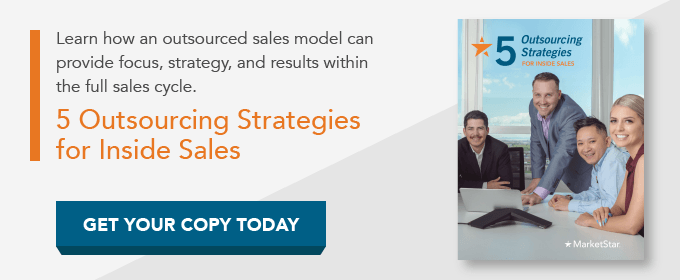B2B selling has become more complex. It used to be that B2B sales was a linear process, and a sales rep would own the customer relationship from lead development through final close and onboarding–then repeat the process.
No longer.
These days, customers are conducting proactive product research, trying to make sense of alternative solutions that meet their business needs. The process has become more complicated, in some cases making the customer less inclined to buy, fearing that they might make a mistake. As a result, the sales rep has to be a solution adviser that builds product confidence, quickly, with the customers.

To keep up with the change in how B2B sales are structured more organizations are using outsourcing sales agencies as an extension of their sales team. This includes outsourcing specialty reps and adding new functions within the sales cycle.
The truth is, when you consider the cost of expanding or starting up your in-house sales team, you’ll find that not only is it easier to outsource your sales, but, it will also be more cost-effective to your bottom line.
The Real Cost of In-House Sales Staffing
When comparing the cost of maintaining an in-house sales team versus the cost of outsourcing sales, you have to take into consideration all of the elements that create overhead, not just salaries, commissions, and bonuses.
Consider, for example, the cost of hiring a sales development representative (SDR) who is paid around $74,000 in salary and bonuses. When you add in the cost of benefits, training, tech stack, infrastructure, taxes, and other administrative overhead, the true cost climbs to $150,000.
Let’s break down the real cost of maintaining your in-house sales team:
-
Staffing—Anytime you add headcount, you have to consider the cost of recruiting and training. Staffing requires both internal resources such as recruiting staff, sourcing staff, and internal management costs, as well as external costs such as recruiters, advertising, background checks, screening fees, agency fees, and more.
According to the Society for Human Resource Management (SHRM), the average cost per hire is around $4,425. That doesn’t include the time required for recruiting, which lengthens with low unemployment rates. It also doesn’t take into account training time, which normally takes up to 10 weeks, and even then it can be a year until new sales reps become 100% productive during each call.
By outsourcing sales, you get access to experienced sales professionals right away. As new staff is required, Sales as a Service® providers can sign new talent faster. At MarketStar, for example, we pride ourselves on being able to hire the best talent 39 percent faster, train them 50 percent faster than in-house, and start driving revenue within 4-6 months.
-
Benefits—In addition to staff acquisition, you have to consider other costs as well, such as staff benefits and employment taxes. Benefits make up 37.7 percent of compensation according to the U.S. Bureau of Labor Statistics, and that doesn’t include employment taxes. When you outsource sales you eliminate that additional overhead.
-
Management overhead—There are going to be additional indirect management costs incurred when you decide to add in-house sales staff. Managers will have to train the new sales team, develop new sales processes, and invest in new technology.
Focusing on making the new reps more productive will also have a negative impact on your managers’ productivity. By collaborating with an outsourced sales team, you can offload those management concerns.
-
Capital expenses—In-house sales reps also require office resources, and that adds to costs. For example, they need desk space, telecommunications services, equipment, software licenses, and more. The cost of office space alone makes sales outsourcing attractive. Consider that the average cost per month of office space in is $85.20 per square foot in New York and $92.70 per square foot in San Francisco.
-
Location—Geography is an important factor when weighing the pros and cons of expanding your in-house sales staff versus hiring Sales as a Service support. Salaries in major metropolitan markets such as New York, Chicago, Seattle, San Francisco, and Los Angeles are bound to be higher because of their competitive job markets and higher cost of living. With an outsourced sales team, geography isn’t a factor. Sales reps can be located anywhere, which means that they are generally less expensive elsewhere.
Shopping for Outsourced Sales
When looking for an outsourced sales provider, the error that many sales executives make is to look at cost savings alone. The real question they need to ask is, “How much more can I make?” Offloading lead generation, lead qualification, and other sales functions that are more expensive to perform in-house, you are freeing your sales team to increase their productivity.
When you consider engaging an outsourced sales company, be sure you seek out quality over cost. You want to work with a Sales as a Service provider that invests in its sales team and has the leadership to help you reach your goals. You want a sales partner that can execute, and you want to consider economies of scale, including your long-term returns versus expenditures.
You are also mitigating risk by relying on a sales partner that is accountable, because your contract should pay for performance, not just process. Using predefined metrics allows you to gauge results—including the increase in sales—and ensure you are getting the value-added support you’re paying for.
When you understand the value of outsourcing sales, you can identify new markets and new sales opportunities, and use your outsourced sales team to generate more sales without taxing your internal sales team.
If you want to learn more about how you can benefit from outsourcing sales, be sure to read our guide, 5 Outsourcing Strategies for Inside Sales.










